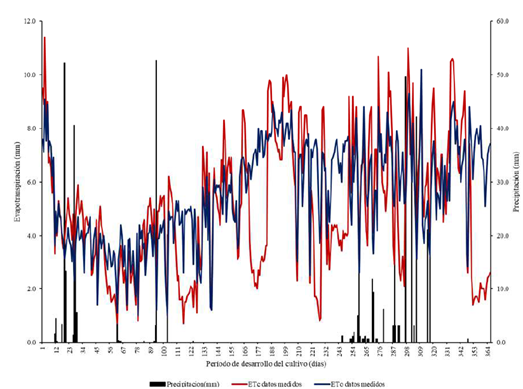Water requirement, crop coefficient and productivity of Convert 330 hybrid grass (brachiaria sp) in a warm semiarid climate of Mexico
DOI:
https://doi.org/10.28940/terra.v42i0.1797Keywords:
evapotranspiration, Fao56 method, Culiacan valleyAbstract
The middle area in Sinaloa state (Mexico) is characterized by a semi-arid climate where rainfall is insufficient for the adequate development of some introduced plant species, such as those corresponding to genus Brachiaria and on the other hand, despite the technological progress in the development of sensors, the access of producers to sufficient meteorological information is scarce; the aim in this work was determining the water requirement, crop coefficient and productivity of Convert 300 hybrid grass (Brachiaria sp) in a warm semiarid climate of Mexico, using FAO56 method with complete data and limited data; a meteorological station was used to measure climatic parameters, and the FAO56 method with dual kc was applied to estimate crop evapotranspiration under non-standard conditions, and subsequently, the water productiviy. The estimated water consumption for the Convert 330 hybrid in the warm semiarid climate was 1,849 mm with measured data and 1,973.5 mm with limited data; statistical analysis yielded a correlation coefficient (r) of 0.96, Willmott’s coefficient of agreement (d) of 0.90, RMSE of 0.694 mm d-1, BIAS of 0.380 mm d-1 and a Nash-Sutcliffe coefficient of efficiency (EF) of 0.98. The kc values were 0.49, 1.11 y 1.04 for ini, mid and end season, respectively; the water productivity (WUE) was 2.666 kg m-3 for green forage, and 0.726 kg m-3, for dry matter, in the same way, 375.1 and 1,378 L kg-1 were required to produce green forage and dry matter, respectively. Likewise, it’s concluded that, althought the ETc estimation with limited data overestimated the ETc with measured data by 6.7%, the statistics show that the procedure is reliable.
Downloads
Publication Facts
Reviewer profiles N/A
Author statements
- Academic society
- Terra Latinoamericana
- Publisher
- Mexican Society of Soil Science, C.A.

















